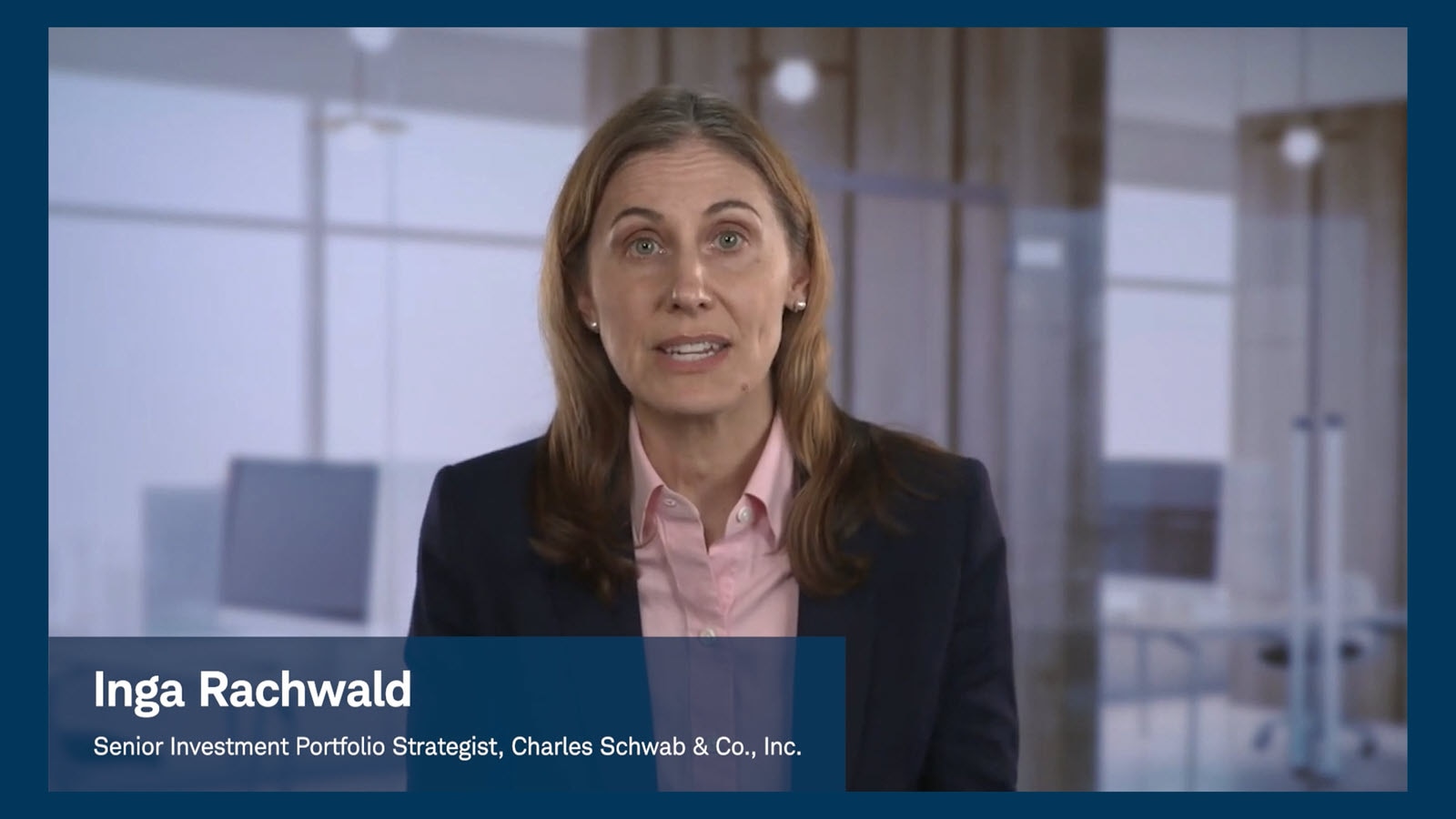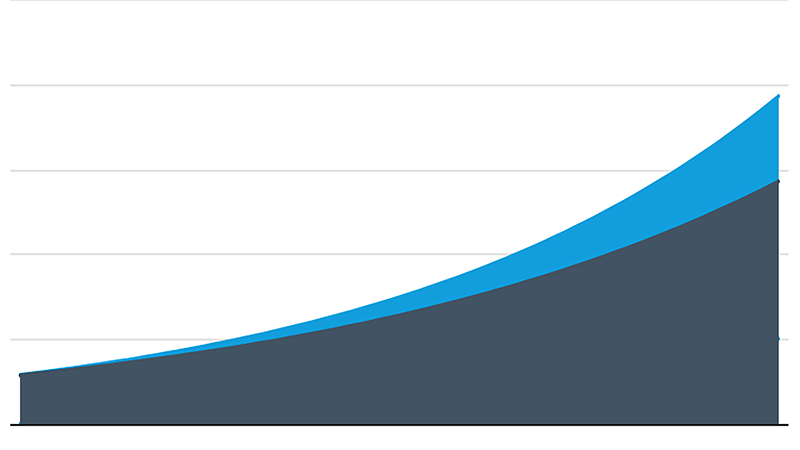INGA RACHWALD: At Schwab Asset Management®, we typically think of income-seeking investors as falling into one of two categories. The first category is investors looking for relatively stable income and preservation of capital. And the second is for investors seeking income that can increase over time, while also achieving potential capital appreciation.
On to the first category, stable income and capital preservation. For your clients who need a reliable income stream, consider looking at fixed income. Bond yields rose sharply in early 2024, as the U.S. Federal Reserve sought to manage persistent inflation alongside a resilient labor market. The good news for fixed income investors is that this backdrop has kept open the window of opportunity to lock in attractive yields across a range of government, credit, duration, and liquidity spectrums as this chart illustrates. At Schwab Asset Management, our Wasmer SchroederTM Strategies, backed by over 35 portfolio managers and analysts, offer separately managed account fixed income solutions across a range of taxable and tax-exempt formats, and across the full credit, quality, and duration spectrum. And if you’re looking for a traditional mutual fund or ETF wrapper for your clients’ fixed income needs instead of a separately managed account, Schwab Asset Management has several offerings in these investment vehicles as well.
Now let’s focus on the second category, investors seeking an increasing income stream and potential capital appreciation. For these clients, dividend-paying stocks might be a good fit, albeit one that is riskier than bonds. Dividend-paying stocks can potentially provide consistent dividend income, dividend growth, and capital appreciation if the underlying stocks perform well. Companies in the S&P 500 Index paid out a record $588 billion in dividends in 2023. Since 1980, S&P 500 companies that grew dividends generally outperformed non-dividend-paying stocks during periods of elevated inflation. Schwab Asset Management’s ThomasPartners® Strategies are separately managed accounts designed to provide clients with income, income growth, and competitive total returns over time through an actively managed approach centered on selecting stocks of companies expected to raise their dividends over time. As with our fixed income opportunities, Schwab Asset Management offers dividend-paying stock strategies in mutual fund and ETF wrappers as well.
And finally, we also offer the Schwab Monthly Income Funds, which are designed to provide investors a choice between three income strategies across asset classes and income sources.
No matter which direction the markets may be headed, some of your clients are likely to need income. Learn more about the many income strategies Schwab Asset Management has to offer your clients at schwabassetmanagement.com. Thanks for listening.
Disclosures
Investors in mutual funds and ETFs should consider carefully information contained in the prospectus or, if available, the summary prospectus, including investment objectives, risks, charges, and expenses. You can obtain a prospectus by visiting schwabassetmanagement.com/prospectus. Please read it carefully before investing.
Investment returns will fluctuate and are subject to market volatility, so that an investor’s shares, when redeemed or sold, may be worth more or less than their original cost. Shares of ETFs are not individually redeemable directly with the ETF. Shares are bought and sold at market price, which may be higher or lower than the net asset value (NAV).
Diversification strategies do not ensure a profit and do not protect against losses in declining markets.
Investments in managed accounts should be considered in view of a larger, more diversified investment portfolio.
The information provided here is for general informational purposes only and should not be considered an individualized recommendation or personalized investment advice. All expressions of opinion are subject to changes without notice in reaction to shifting market, economic, and geopolitical conditions.
Data herein is obtained from what are considered reliable sources; however, its accuracy, completeness, or reliability cannot be guaranteed. Supporting documentation for any claims or statistical information is available upon request.
Please refer to the Charles Schwab Investment Management, Inc. Disclosure Brochure for additional information.
There are risks associated with any investment approach, and the ThomasPartners Strategies have their own set of risks:
First, there are the risks associated with investing in dividend-paying stocks, including but not limited to the risk that stocks in the Strategies may reduce or stop paying dividends, affecting the Strategy’s ability to generate income.
Second, investor sentiment could cause dividend-paying equities to fall out of favor and decrease in price.
Third, there are risks associated with investing in fixed income asset classes, including through the use of exchange traded funds (ETFs), that include but are not limited to: interest rate risk, credit risk, high yield risk, and government security risk.
Fourth, there are risks associated with investing in international stocks, including but not limited to: differences in financial accounting standards, currency fluctuations, geopolitical risk, foreign taxes and regulations, and the potential for illiquid markets.
Fifth there are risks with Master Limited Partnership (MLP) securities (units) that differ from an investment in common stock. Holders of the units of MLPs have more limited control and limited rights to vote on matters affecting the partnership. For example, unit holders may not elect the general partner or the directors of the general partner, and they have limited ability to remove a MLP’s general partner. MLPs may issue additional common units without unit holder approval, which would dilute existing unit holders. In addition, conflicts of interest may exist between common unit holders, subordinated unit holders, and the general partner of a MLP, including a conflict arising as a result of incentive distribution payments. As an income producing investment, MLPs could be affected by increases in interest rates and inflation. There are also certain tax related risks associated with an investment in units of MLPs, including that MLPs may convert to a C-Corporation. This conversion could cause a cut in distributions as well as an adverse tax event for long-time owners of the MLP.
Lastly there are risks associated with Real Estate Investment Trusts (REITs), including REITs will be subject to the risks associated with the direct ownership of real estate, including fluctuations in the value of underlying properties, defaults by borrowers or tenants, changes in interest rates and risks related to general or local economic conditions. REITs are also subject to certain additional risks, for example, REITs are dependent upon specialized management skills and cash flows, and may have their investments in relatively few properties, a small geographic area or a single property type. Failure of a company to qualify as a REIT under federal tax law may have adverse consequences on a client account. In addition, REITs have their own expenses, and a client account will bear a proportionate share of those expenses.
There are risks associated with any investment approach, the Wasmer Schroeder Strategies have their own set of risks. The Wasmer Schroeder Strategies invests primarily in fixed income instruments and as such the strategies are subject to various risks including but not limited to interest rate risk, reinvestment risk, credit risk, default risk and event risk. Fixed income securities are subject to increased loss of principal during periods of rising interest rates. Fixed income investments are subject to various other risks including changes in credit quality, market valuations, liquidity, prepayments, early redemption, corporate events, tax ramifications and other factors.
Source: Bloomberg Index Services Limited. BLOOMBERG® is a trademark and service mark of Bloomberg Finance L.P. and its affiliates (collectively “Bloomberg”). Bloomberg or Bloomberg’s licensors own all proprietary rights in the Bloomberg Indices. Neither Bloomberg nor Bloomberg’s licensors approves or endorses this material, or guarantees the accuracy or completeness of any information herein, or makes any warranty, express or implied, as to the results to be obtained therefrom and, to the maximum extent allowed by law, neither shall have any liability or responsibility for injury or damages arising in connection therewith.
Portfolio Management for the ThomasPartners Strategies, Wasmer Schroeder Strategies is provided by Charles Schwab Investment Management, Inc., dba Schwab Asset Management®, a registered investment adviser and an affiliate of Charles Schwab & Co., Inc. ("Schwab"). Schwab Asset Management and Schwab are separate entities and subsidiaries of The Charles Schwab Corporation.
Monthly Income Funds
There is no guarantee that the funds will make monthly income payments or that the amount of such payments will remain fixed throughout the year. Each fund's actual annual payout may vary from one year to the next and over time due to several factors, including, without limitation, the interest rate environment, the performance of the financial markets in which the fund invests, the allocation of fund assets across different asset classes and investments, and the amount and timing of prior distributions by the fund. Although each fund has its own distinct asset allocation strategy that is designed to accommodate the fund's targeted annual payout percentage while taking into account the fund's specific risk tolerances and desired level of capital appreciation, the fund's actual annual payout could be higher or lower. Each fund's monthly income payments will be made from fund assets and will reduce the amount of assets available for investment by the fund. Any income payments made during periods when fund assets are decreasing due to market conditions or shareholder redemptions will further decrease the fund's assets.






